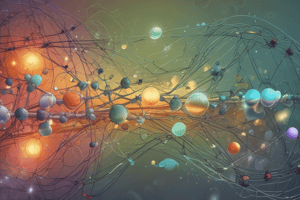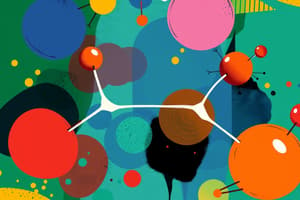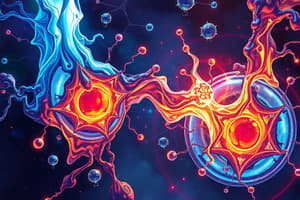Podcast
Questions and Answers
What is the primary product of glycolysis?
What is the primary product of glycolysis?
In which cellular location does the Krebs Cycle occur?
In which cellular location does the Krebs Cycle occur?
What is the final electron acceptor in oxidative phosphorylation?
What is the final electron acceptor in oxidative phosphorylation?
Which products are generated during the light reactions of photosynthesis?
Which products are generated during the light reactions of photosynthesis?
Signup and view all the answers
Which enzyme is involved in the Calvin Cycle to fix carbon dioxide?
Which enzyme is involved in the Calvin Cycle to fix carbon dioxide?
Signup and view all the answers
What defines Gibbs Free Energy in a reaction?
What defines Gibbs Free Energy in a reaction?
Signup and view all the answers
What causes enzyme denaturation?
What causes enzyme denaturation?
Signup and view all the answers
What is the primary role of competitive inhibitors?
What is the primary role of competitive inhibitors?
Signup and view all the answers
Study Notes
Endergonic Reactions
- Endergonic reactions absorb energy; they are not spontaneous processes.
- An example is ADP gaining a phosphate group to become ATP.
Exergonic Reactions
- Exergonic reactions release energy; they are spontaneous.
- An example is ATP losing a phosphate group to become ADP.
Enzymes
- Biological catalysts
- Speed up chemical reactions.
- Reduce activation energy needed for reactions.
- Are proteins
- Are not consumed in the reaction.
- Have no effect on Gibbs Free Energy change
- Active site is where substrates bind.
- Competitive inhibitors bind to active site
- Non-competitive inhibitors bind to allosteric site
- Environmental factors like temperature and pH can impact enzyme function. (denaturation outside of optimal range)
Gibbs Free Energy
- Energy available to do work
- ΔG = ΔH - TΔS
Where:
- ΔG = change in Gibbs Free Energy
- ΔH = change in enthalpy (change in heat content)
- T= temperature in Kelvin
- ΔS = change in entropy (change in disorder)
Cellular Respiration
- Glycolysis:
- Location: Cytoplasm
- Starting material: Glucose
- Products: 2 pyruvate, 2 ATP, 2 NADH
- Krebs Cycle (Citric Acid Cycle):
- Location: Mitochondrial Matrix
- Starting material: Acetyl CoA
- Products: 2 CO2, 3 NADH, 1 FADH2, 1 ATP
- Oxidative Phosphorylation:
- Location: Inner mitochondrial membrane (cristae)
- Starting materials: NADH/FADH2 (electrons)
- Products: ATP
- The electron transport chain and chemiosmosis.
- Electron transport chain: moves electrons to oxygen (final electron receptor), creating a proton gradient across the inner mitochondrial membrane.
- Chemiosmosis: protons flow down the gradient, through ATP synthase, generating ATP
Photosynthesis
- Light Reactions:
- Location: Thylakoid membrane
- Starting materials: Water, photons (light energy), electrons
- Products: ATP, NADPH
- Calvin Cycle:
- Location: Stroma
- Starting materials: CO2, ATP, NADPH
- Products: glucose (sugar)
Photosynthesis Chemical Reaction
- 6 CO₂ + 12 H₂O + light energy → C₆H₁₂O₆ + 6 O₂ + 6 H₂O
Chlorophyll
- Absorbs light (energy)
- Receives electrons or transfers them to electron transport chains.
Multiple Choice Practice
- If water labeled with 18O is the input to photosynthesis, then the oxygen released is also labeled with 18O because water is split during the light reactions, releasing oxygen.
Free Response Practice
- Noncyclic electron flow: electrons move through photosystem II, then parts of the chloroplast electron transport chain, and finally photosystem I, to generate NADPH
- Cyclic electron flow: electrons cycle through photosystem I and some components of the electron transport chain.
- Chlorophyll's role: absorbs light energy and receives/transfers electrons in the photosystems.
- Increase in NADPH:to NADP+ ratio causes less NADP+ to accept electrons, thus leading to more electrons going through the cyclic pathway.
Studying That Suits You
Use AI to generate personalized quizzes and flashcards to suit your learning preferences.
Related Documents
Description
Explore the fascinating world of endergonic and exergonic reactions and their role in biological systems. This quiz delves into the function of enzymes, the impact of environmental factors, and the intricacies of Gibbs Free Energy calculations. Test your knowledge on these fundamental concepts in biochemistry.




